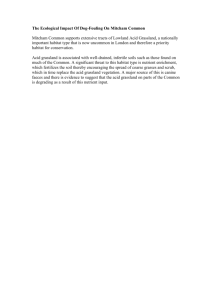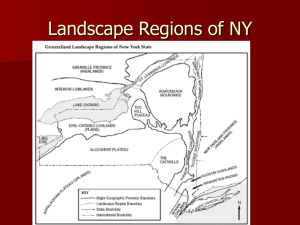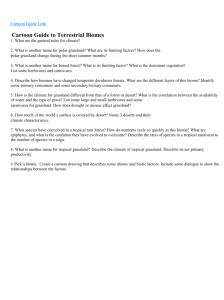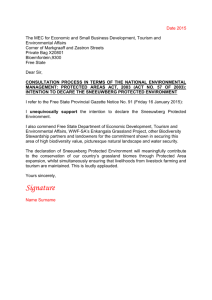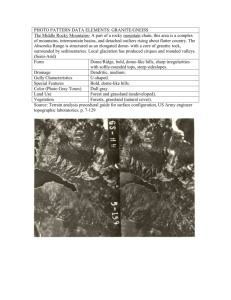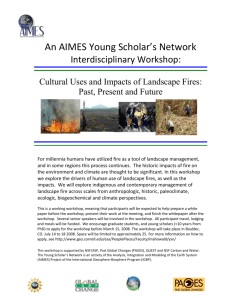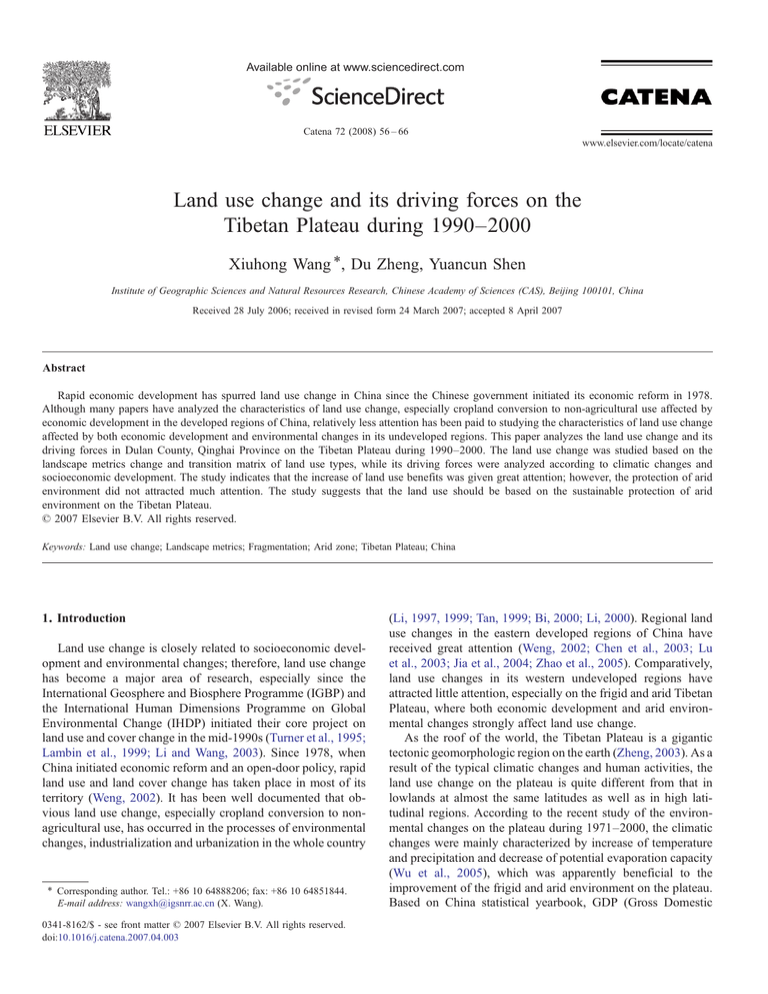
Available online at www.sciencedirect.com
Catena 72 (2008) 56 – 66
www.elsevier.com/locate/catena
Land use change and its driving forces on the
Tibetan Plateau during 1990–2000
Xiuhong Wang ⁎, Du Zheng, Yuancun Shen
Institute of Geographic Sciences and Natural Resources Research, Chinese Academy of Sciences (CAS), Beijing 100101, China
Received 28 July 2006; received in revised form 24 March 2007; accepted 8 April 2007
Abstract
Rapid economic development has spurred land use change in China since the Chinese government initiated its economic reform in 1978.
Although many papers have analyzed the characteristics of land use change, especially cropland conversion to non-agricultural use affected by
economic development in the developed regions of China, relatively less attention has been paid to studying the characteristics of land use change
affected by both economic development and environmental changes in its undeveloped regions. This paper analyzes the land use change and its
driving forces in Dulan County, Qinghai Province on the Tibetan Plateau during 1990–2000. The land use change was studied based on the
landscape metrics change and transition matrix of land use types, while its driving forces were analyzed according to climatic changes and
socioeconomic development. The study indicates that the increase of land use benefits was given great attention; however, the protection of arid
environment did not attracted much attention. The study suggests that the land use should be based on the sustainable protection of arid
environment on the Tibetan Plateau.
© 2007 Elsevier B.V. All rights reserved.
Keywords: Land use change; Landscape metrics; Fragmentation; Arid zone; Tibetan Plateau; China
1. Introduction
Land use change is closely related to socioeconomic development and environmental changes; therefore, land use change
has become a major area of research, especially since the
International Geosphere and Biosphere Programme (IGBP) and
the International Human Dimensions Programme on Global
Environmental Change (IHDP) initiated their core project on
land use and cover change in the mid-1990s (Turner et al., 1995;
Lambin et al., 1999; Li and Wang, 2003). Since 1978, when
China initiated economic reform and an open-door policy, rapid
land use and land cover change has taken place in most of its
territory (Weng, 2002). It has been well documented that obvious land use change, especially cropland conversion to nonagricultural use, has occurred in the processes of environmental
changes, industrialization and urbanization in the whole country
⁎ Corresponding author. Tel.: +86 10 64888206; fax: +86 10 64851844.
E-mail address: wangxh@igsnrr.ac.cn (X. Wang).
0341-8162/$ - see front matter © 2007 Elsevier B.V. All rights reserved.
doi:10.1016/j.catena.2007.04.003
(Li, 1997, 1999; Tan, 1999; Bi, 2000; Li, 2000). Regional land
use changes in the eastern developed regions of China have
received great attention (Weng, 2002; Chen et al., 2003; Lu
et al., 2003; Jia et al., 2004; Zhao et al., 2005). Comparatively,
land use changes in its western undeveloped regions have
attracted little attention, especially on the frigid and arid Tibetan
Plateau, where both economic development and arid environmental changes strongly affect land use change.
As the roof of the world, the Tibetan Plateau is a gigantic
tectonic geomorphologic region on the earth (Zheng, 2003). As a
result of the typical climatic changes and human activities, the
land use change on the plateau is quite different from that in
lowlands at almost the same latitudes as well as in high latitudinal regions. According to the recent study of the environmental changes on the plateau during 1971–2000, the climatic
changes were mainly characterized by increase of temperature
and precipitation and decrease of potential evaporation capacity
(Wu et al., 2005), which was apparently beneficial to the
improvement of the frigid and arid environment on the plateau.
Based on China statistical yearbook, GDP (Gross Domestic
X. Wang et al. / Catena 72 (2008) 56–66
Product) in the Tibetan Autonomous Region and Qinghai
Province has clearly increased following the 1978 reforms,
especially in 1990s (NBSC, 1991–2003a). However, rapid
population growth had occurred on the plateau in the same
period. The aforesaid climatic and human factors greatly affect
the land use change on the plateau. Better understanding of the
processes that resulted in changing land use in the past may
enable the improvement of future planning strategies (Shoshany
and Goldshleger, 2002). Thus, a study of land use change and its
driving forces on the Tibetan Plateau is much needed.
The objective of this paper is to analyze land use change
pattern using a geographical information system (GIS) and
patch analysis methods and to discuss its driving forces based
on the climatic changes and socioeconomic development,
which will benefit the process study of land use change and
land-use planning on the Tibetan Plateau.
2. Study area
Located between 95°34′–99°40′ E and 35°20′–37°22′ N
and situated on a transitional belt between the frigid Tibetan
Plateau and the arid Northwest China, Dulan County of Qinghai
Province covers an area of approximately 54,269 km2 (Fig. 1).
It is mainly characterized by arid climate and basin landscape.
Air temperature spatially increases from southeast to northwest
with a mean annual value of 2.7 °C–4.4 °C. The coldest month
(January) generally has a mean air temperature ranging from
− 10.6 °C to − 10.1 °C, while the warmest month (July) usually
has a mean air temperature ranging from 14.9 °C to 17.2 °C.
Sunshine and solar radiation are quite high, which partly
57
compensate for the disadvantageous low temperature. Precipitation increases from northwest to southeast with a mean
annual precipitation of 37–296 mm. Evaporation is quite strong
with a mean annual evaporation capacity of 2088–2716 mm.
Frequent strong wind is another climatic feature directly
affecting agricultural development and arid environment,
which becomes stronger from east to west with a mean annual
speed of 3.5 m s− 1. After autumn harvest, strong soil erosion
usually occurs on cropland. Located in the eastern part of the
Qaidam Basin, Dulan County has a plain area with an elevation
between 2675 m and 3300 m, and a mountain area with an
elevation between 3300 m and 5536 m (MCA, 1993; Wang,
1995; Zhao, 1998). Many alpine and desert soils can be found,
which have very coarse soil texture. These physical conditions
result in the fact that most of the area of Dulan County is
covered by unused land (56%) and grassland (41%).
As a Mongolian place name, “Dulan” means warm. It
historically indicates that the physical conditions for agricultural production in Dulan County are relatively satisfactory
compared with that in other parts of the frigid plateau. Holding
the highest record for spring wheat yield of 15,195 kg ha− 1
(1978) in China and having large grassland, Dulan County is a
famous agricultural county in China.
Following the 1978 economic reforms, grain production and
animal husbandry have still played an important role in the local
economic development, since the county's economy is still
dominated by agriculture. The formation of cropland needs special conditions, regarding elevation, soil texture, water resources
and infrastructure. As temperature decreases with increasing
elevation, the areas with an elevation less than 3250 m generally
Fig. 1. Study area and location of Dulan County on the Tibetan Plateau, China.
58
X. Wang et al. / Catena 72 (2008) 56–66
have higher temperature favorable to the growth of some crops
(one crop a year), such as spring wheat, horsebean, potato, cole
and many kinds of vegetables. From the upper part to the lower
part of alluvial fans, soil texture becomes fine, fine soil depth
increases, soil fertility enhances, but soil salt content also
increases. Therefore, it is only the middle part of alluvial fans
that possess soils favorable to crop growth. Without irrigation,
farming is impossible. Although some rivers seep into the
ground after running out the mountain areas, many rivers
overflow near the edge of alluvial fans. Moreover, some larger
rivers directly reach the fine earth belts. Gainable water
resources make irrigation and cultivation possible. Apart from
the aforesaid conditions, better economic conditions, especially
transportation, are also favorable to cropland expansion. The
above-mentioned four conditions affect each other and work
together. Thus, cropland is mainly distributed on the fine earth
belts with an elevation ranging from 2800 m to 3000 m. It is
horizontally along the sides of roads and vertical to the flow
directions of rivers (Wang and Hu, 1998). However, irrational
expansion of cropland usually accelerates wind erosion and soil
secondary salinization.
Widely distributed in the study area, grassland can be
divided into many types based on vegetation types and
landform characteristics. It includes plain meadow, montane
meadow, alpine meadow, swamping meadow, shrub meadow,
sparse forest meadow, montane steppe, alpine steppe, plain
desert, and montane desert. Many vegetation types can be found
on the grasslands in Dulan County, such as xerophyte,
mesophyte, hygrophyte and halophyte on different landforms.
Vegetations usually have a mean height of 5–80 cm (some
reaching about 200 cm) and a mean coverage of 5–70% (Ma,
1995).
3. Data and methods
3.1. Database
The use of satellite remote sensing has been proven to be a
good choice for detecting and monitoring land use transformation
(Longley, 2002). In this study, we used the digital land use dataset
(vector) at a scale of 1:100 000 in 1990 and 2000 developed by the
Resources and Environment Data Center, Chinese Academy of
Sciences (CAS) (Liu et al., 2003, 2005a,b,c).
The dataset is based on the Landsat Thematic Mapper (TM)
remotely sensed data for the whole country with a maximal
spatial resolution of 30 m. The Landsat images were enhanced
using the linear contrast stretching and histogram equalization
to help identify ground control points in the rectification to a
common ALBERS coordinate system based on 1: 100 000
topographic maps of China. The land use classification was
conducted through visual interpretation to guarantee the
consistency and accuracy of data processing. After geometric
correction and georeferencing, the average location errors in the
Landsat images are less than 50 m (about 2 pixels). Field survey
and random sample check show that the overall interpretation
accuracy for land use classification is 92.92% for 1990 and
97.45% for 2000 (Liu et al., 2005c).
A hierarchical classification system of 25 land-cover
subclasses was applied to the Landsat TM/ETM (Enhanced
Thematic Mapper) data. The 25 subclasses of land cover were
further grouped into 6 aggregated classes of land cover: croplands, woodlands, grasslands, water bodies, unused land and
built-up areas including urban areas. Croplands include paddy
and dry farming land. Woodlands include forest, shrub and
others. Grasslands include three density-dependent types:
dense, moderate and sparse grass. Water bodies include stream
and rivers, lakes, reservoir and ponds, glacier and firn, beach
and shore, and bottomland (overflow land). Unused land includes sandy land, Gobi, salinized land, wetland, bare soil, bare
rock and others such as alpine desert and tundra. Built-up land
includes urban area, rural settlements and others such as roads
and airports (Liu et al., 2005a,b,c). In this study, we selected
some related subclasses and class as land use patch types according to our field investigation (Table 1). Land use maps of
Dulan County in 1990 and 2000 were displayed by using a GIS
software ArcView 3.2 (Fig. 2).
To explain the reasons for land use change, the authors selected
some related data reflecting climatic changes and human activities.
The climatic data was obtained from the Meteorological
Information Center, China Meteorological Administration, while
the socioeconomic data was from the Qinghai Statistical Yearbook
(NBSC, 1991–2003b).
3.2. Methods
The Patch Analyst module was used to calculate the
landscape metrics, which is an extension to the ArcView GIS
Table 1
Land use patch types and their definitions in Dulan County
Patch ID Patch type
11
21
22
23
31
32
33
41
42
43
44
45
50
61
62
63
64
Irrigated cropland
Dense forest
Scrubland
Definition
Irrigated crops can ripen once a year.
Woodland with a crown density N30%
Scrubland with a crown density N40%
and height less than 2 m
Sparse forest
Woodland with a crown density of
10%–30%
Higher coverage grassland Grassland with a coverage N50%
Medium coverage grassland Grassland with a coverage between
20% and 50%
Lower coverage grassland Natural grassland with a coverage
of 5%–20%
River and channel
Natural river and artificial channel
Lake
Natural lake
Reservoir and pond
Artificial water area
Glacier and firn
Land covered with glacier and firn
Overflow land
Flood-affected land on riverside or
lakeside
Built-up land
Residential area and land for stand
alone industrial and mining sites
Sandy land
Land covered with sand, vegetation
coverage b5%
Marsh
Land with accumulated water and
hygrocolous plants
Salinized land
Land with more salt gathered on top soil
Desert land
Stony and alpine deserts with a
vegetation coverage b5%
X. Wang et al. / Catena 72 (2008) 56–66
system that facilitates the spatial analysis of landscape patches,
and modeling of attributes associated with patches (Rempel and
Carr, 2003). Two levels of metrics were computed, i.e., class
level, which means each land use type (patch type) in the landscape mosaic, and landscape level, which means the landscape
59
mosaic as a whole (Lu et al., 2003). The various patch metrics
follow the definitions in FRAGSTATS (McGarigal and Marks,
1994). Patch Analyst is capable of calculating a lot of landscape
metrics. However, many of them can be highly correlated. In
this analysis of the change of landscape metrics at the class
Fig. 2. Land use maps of Dulan County in 1990 and 2000.
60
X. Wang et al. / Catena 72 (2008) 56–66
level, five indices were selected: percent of landscape (PL),
number of patches (NP), mean patch size (MPS), patch size
coefficient of variance (PSCV), and area-weighted mean patch
fractal dimension (AWMPFD). AWMPFD reflects shape
complexity weighted by the area of patches. Land use patches
with simple or regular shape usually have a low AWMPFD.
Human activities usually make the shape of land use patches
simple or regular. To make the phenomena of land use change
easier to understand, cluster analysis was used to regroup land
use types based on changing ratios of landscape metrics during
1990–2000. For the analysis of the change of landscape metrics
at the landscape level, Shannon's diversity index (SDI) was
selected (Table 2).
The magnitude and direction of changes in landscape are the
most important factors relating to landscape evolution (Antrop,
2000). To define the transition of land use types in Dulan
County during 1990–2000, the authors used Overlay Tool in the
GIS software Arc/Info 8.3 to compute the geometric intersection of two periods of land use maps. The output coverage file
was converted into shape file. The cross-tabulation table was
calculated by using the PivotTable Wizard in Microsoft Excel,
which was output as a transition matrix. The magnitude and
direction of land use change was determined based on the
transition matrix.
4. Results
4.1. Comparison of landscape metrics
Table 3 lists landscape metrics at class level and landscape
level in 1990 and 2000. It is clear that land use patch types
directly affected by human activities usually have a lower
AWMPFD(≤ 1.30) (except for two types of natural water area
of lake and glacier and firn). This is because that more human
influence makes the shape of land use patches simpler or more
regular. Geomorphology or flow direction of river mainly
affects patterns of the patches in land use map. The plain area
usually has patches elongating in northwest direction; whereas
the mountain area usually has patches elongating in northeast
direction (Fig. 2). Cluster analysis of landscape metrics
(variables) at class level indicated that percent of landscape,
patch size coefficient of variance, and area-weighted mean
patch fractal dimension are relatively independent variables.
Based on the changing ratios of three mentioned landscape
Table 2
Definitions of landscape metrics
Landscape metrics
Percent of landscape (PL)
Short description
Percentage of the landscape comprised of
the corresponding patch type
Number of patches (NP)
Total number of patches in the landscape
Mean patch size (MPS)
Average patch size
Patch size coefficient of variance Variability in patch size relative to the
(PSCV)
mean patch size
Area-weighted mean patch fractal Shape complexity weighted by the area of
dimension (AWMPFD)
patches
Shannon diversity index (SDI)
Measure of relative patch richness
Table 3
Landscape metrics in Dulan County in 1990 and 2000
Patch type
1990
Irrigated
cropland
Dense forest
Scrubland
Sparse forest
Higher
coverage
grassland
Medium
coverage
grassland
Lower
coverage
grassland
River and
channel
Lake
Reservoir and
pond
Glacier and
firn
Overflow land
Built-up land
Sandy land
Marsh
Salinized land
Desert land
landscape
2000
Irrigated
cropland
Dense forest
Scrubland
Sparse forest
Higher
coverage
grassland
Medium
coverage
grassland
Lower
coverage
grassland
River and
channel
Lake
Reservoir and
pond
Glacier and
firn
Overflow land
Built-up land
Sandy land
Marsh
Salinized land
Desert land
landscape
CA
PL
NP
MPS PSCV AWMPFD SDI
28,091
0.52
125
225
335
1.29
7140
32,707
33,108
30,406
0.13
0.60
0.61
0.56
45
787
476
147
159
42
70
207
155
843
255
174
1.28
1.32
1.31
1.30
1,071,115
19.74
2866
374
488
1.35
1,130,668
20.83
2786
406
661
1.34
1138
0.02
1 1138
0
1.43
12,180
108
0.22
0.00
93
4
131
27
576
103
1.20
1.22
10,215
0.19
276
37
208
1.27
7590
0.14
34 223 180
4973
0.09
161
31 529
324,798
5.98
246 1320 638
223,438
4.12
500 447 742
232,598
4.29
561 415 313
2,276,665 41.95 1331 1710 2101
5,426,937 100.00 10439 520 2509
1.41
1.26
1.31
1.36
1.32
1.43
1.38
33,979
0.63
103
330
305
1.28
7141
32,486
32,900
31,357
0.13
0.60
0.61
0.58
45
778
458
137
159
42
72
229
155
843
253
194
1.28
1.32
1.31
1.30
1,066,956
19.66
2834
376
485
1.35
1,129,013
20.80
2740
412
662
1.34
1138
0.02
1 1138
0
1.43
12,187
115
0.22
0.00
90
5
135
23
557
122
1.19
1.22
10,215
0.19
276
37
208
1.27
7520
0.14
32 235 175
5921
0.11
161
37 540
325,787
6.00
243 1341 635
220,765
4.07
457 483 712
232,944
4.29
550 424 313
2,276,513 41.95 1329 1713 2100
5,426,937 100.00 10239 530 2485
1.41
1.24
1.31
1.36
1.32
1.43
1.38
1.726
1.724
ID: ID of land use type; CA: class area (ha); PL: percent of landscape (%); NP:
number of patches; MPS: mean patch size (ha); PSCV: patch size coefficient of
variance; AWMSI: area-weighted mean shape index; AWMPFD: area-weighted
mean patch fractal dimension; SDI: Shannon's diversity index.
X. Wang et al. / Catena 72 (2008) 56–66
metrics, cluster analysis of land use path types (cases) was used
to regroup land use types (Fig. 3). The analysis indicated that
there is obvious difference in landscape metrics change between
land use types with higher land use benefits and land use types
with lower land use benefits.
4.1.1. Landscape metrics change of land use types with higher
land use benefits
Cropland occupied only about 0.52% of the total land area in
1990, but it was the most highly variable land use type. Its NP
decreased from 125 to 103, while its MPS increased from
225 ha to 330 ha. Both its PSCV and AWMPFD decreased.
Built-up land was only about 0.1% of the total land area,
however it was also variable. Its NP did not change, yet, its MPS
expanded from 31 ha to 37 ha. Its PSCV slightly increased, but
its AWMPFD decreased. Higher coverage grassland is
commonly affected by animal husbandry. Its NP decreased
from 147 to 137, whereas its MPS, PSCV and AWMPFD
increased. Reservoir and pond is very important to irrigation. Its
NP increased from 4 to 5, but its MPS shrank from 27 ha to
23 ha. Both its PSCV and AWMPFD increased.
4.1.2. Landscape metrics change of land use types with lower
land use benefits
Overflow land and marsh are essential to environmental
protection. Overflow land had an NP decreasing from 34 to 32,
and an MPS increasing from 223 ha to 235 ha. Both its PSCV
and AWMPFD decreased. Marsh had an NP decreasing from
500 to 457, and an MPS expanding from 447 ha to 483 ha. Its
PSCV decreased, however, its AWMPFD slightly increased.
Other land use types usually had a decreasing NP, increasing
MPS, decreasing PSCV and decreasing or stable AWMPFD.
Comparison of the changes of landscape metrics at landscape
level showed that the study area had an NP decreasing from
10,439 to 10,239, an MPS expanding from 520 ha to 530 ha, a
61
PSCV decreasing from 2509 to 2485, and an SDI decreasing
from 1.726 to 1.724.
4.2. Magnitude and direction of land use change
Indicated by AWMPFD and based on our field investigation,
land use types with higher land use benefits (cropland, dense
forest, higher coverage grassland, reservoir and pond, and builtup land) belonged to artificial landscapes; while land use types
with higher environmental value but lower land use benefits
(scrubland, sparse forest, medium coverage grassland, lower
coverage grassland, river, lake, glacier and firn, overflow land,
and marsh) were usually close to natural landscapes. The
expansion of some artificial landscapes were usually forced
by socioeconomic development and aided by climatic conditions, while the changes among natural landscapes were usually forced by natural factors. The magnitude and direction of land
use change in Dulan County during 1990–2000 were summarized concerning economic development and environmental
protection.
4.2.1. Land use change driven by economic development
As shown in Table 4, cropland and built-up land remarkably
increased by 20.96% and 19.08%, reservoir and pond and
higher coverage grassland moderately increased by 5.92% and
3.13% from 1990 to 2000, respectively. Cropland expansion
mainly resulted from shrinkage of lower coverage grassland
(8.87%), medium coverage grassland (7.10%), salinized land
(1.41%) and sparse forest (1.05%). Built-up land expanded
mainly because some marsh (7.51%), salinized land (4.00%),
cropland (2.72%) and lower coverage grassland (1.68%) were
converted into built-up land. Reservoir and pond expanded
mainly by occupying some cropland (2.76%) and lake (2.82%);
whereas higher coverage grassland expanded mainly by occupying some medium coverage grassland (3.93%).
Fig. 3. Cluster analysis of land use types based on landscape metrics change.
62
X. Wang et al. / Catena 72 (2008) 56–66
Table 4
Magnitude and direction of land use change in Dulan County during 1990–
2000 (%)
Patch type
Change
Land loss (mainly
converted to)
Land expansion (mainly
converted from)
Irrigated cropland
20.96
Dense forest
Scrubland
Sparse forest
Higher coverage
grassland
Medium coverage
grassland
Lower coverage
grassland
River and channel
Lake
0.01
− 0.68
− 0.63
3.13
63(0.96), 51(0.57),
33(0.44), 61(0.19),
32(0.15)
23(0.52)
11(0.65)
11(1.08)
33(0.46), 62(0.21),
31(0.15), 64(0.10)
11(0.23), 33(0.13),
31(0.12)
11(0.27), 32(0.11)
33(8.87), 32(7.10),
63(1.41), 23(1.05),
61(0.16)
32(0.53)
33(0.03)
32(0.41), 21(0.11)
32(3.93)
33(1.28), 62(0.29),
63(0.27), 32(0.11)
Reservoir and pond
Glacier and firn
Overflow land
5.92
0.00
− 0.92
45(0.85), 32(0.51),
33(0.36), 62(0.30)
11(2.79), 42(2.79)
42(1.36), 33(0.17),
11(0.13)
33(0.42), 32(0.18)
Built-up land
19.08
Sandy land
Marsh
0.30
− 1.20
Salinized land
Desert land
− 0.39
− 0.15
0.00
0.06
0.15
− 0.01
11(0.02)
63(0.79), 33(0.41),
32(0.27), 50(0.20)
33(0.52), 11(0.21),
32(0.12), 51(0.10)
61(0.01)
33(0.11)
32(0.12), 63(0.11)
62(7.51), 63(4.00),
11 (2.72), 33(1.68)
33(0.17)
33(0.27), 32(0.25)
62(0.75), 32(0.20),
11(0.12)
Change = (S2000 − S1990) / S1990 (%), S2000 and S1990: land use areas in 1990 and
2000.
Number in front of the parenthesis is ID of land use patch type.
Number in the parenthesis is the percent of land conversion of the corresponding
type.
4.2.2. Land use change detrimental to environmental
protection
During 1990–2000, marsh and overflow land decreased by
1.20% and 0.92%; whereas scrubland, sparse forest, medium
coverage grassland and lower coverage grassland slightly
decreased by 0.68%, 0.63%, 0.39% and 0.15%, respectively.
Marsh shrank mainly because it changed into salinized land
(0.79%); while overflow land decreased mainly because it
changed into lake. The shrinkage of scrubland, sparse forest,
medium coverage grassland and lower coverage grassland was
mainly caused by cropland expansion. Sandy land and salinized
land slightly increased by 0.30% and 0.15%, respectively.
Conversion of some lower coverage grassland into sandy land
mainly resulted in the slight increase of sandy land; while
salinization of some marsh, medium coverage grassland and
cropland led to the slight increase of salinized land.
5. Discussion
5.1. Climatic changes affected land use change
According to the climatic changes in Dulan County during the
period 1970–2002, climatic conditions were generally favorable
to agricultural development in the study area. The mean annual air
temperature increased with a rate of 0.39 °C per decade, and
obviously increased with a higher rate in the 1990s. The annual
precipitation increased with a rate of 10.6 mm per decade (Fig. 4).
According to the relative study during 1960–2000 by Chen and
Wu (2002), although the precipitation in autumn decreased, the
precipitation in the other three seasons and the mean annual
precipitation increased; the precipitation during crop growing
period (from April to September) clearly increased with a rate of
10.8 mm per decade. The wind speed generally decreased with a
rate of 0.4 m s− 1 per decade during 1960–2000; however, it
slightly increased in the end of 1990s. The evaporation capacity
decreased with a rate of 124.3 mm per decade. Evaporation
capacity is non-linearly correlated to many geographic elements,
such as air temperature, air pressure, wind speed, relative humidity and characteristic of underlaying surface. It decreased
partly because precipitation increased and wind speed decreased
on the plateau.
Low temperature, scarce precipitation and high evaporation
capacity are usually limiting factors affecting agricultural
development on the frigid and arid plateau. Thus, the abovementioned climatic changes were generally favorable to
expansion of cropland and high coverage grassland and increase
in area and patch number of reservoir and pond in the study
area. Similar to the highlands of Chiapas in Mexico, the increase
of agricultural lands also depends on other factors such as slope
angle, soil depth and the availability of water sources (OchoaGaona and Gonzalez-Espinosa, 2000).
However, the increase of the mean annual temperature and
wind speed in the end of 1990s likely contributed to the expansion of sandy land and salinized land and shrinkage of
marsh. Distributed on relatively high or sunny places with low
soil moisture, some lower coverage grassland easily converted
into sandy land. Comparatively, distributed on relatively low
places, some marsh, medium coverage grassland and cropland
easily changed into salinized land. Continuous expansion of
sandy land and salinized land and shrinkage of marsh are
harmful to environmental protection and sustainable agricultural
development.
5.2. Economic development spurred land use change
Apart from climatic factors, economic development obviously spurred land use change. During 1990–2002, the average
annual growth rate of GDP in the study area was about 23.5%
(NBSC, 1991–2003b). Contributions to the growth rate from
primary, secondary and tertiary industry were 8.2%, 6.9% and
8.3%, respectively (Fig. 5).
Just like other parts of West China (Li and Wang, 2003), crop
production and animal husbandry have still played the most
important role in the local people's life. For increasing their
income and supporting growing rural population, the local
people tried to expand cropland, higher coverage grassland, and
reservoir and pond with higher economic benefits. Development
of secondary and tertiary industry, as well as primary industry,
also spurred built-up land expansion. In 1990, urban land, rural
residential area and other built-up land (factory, industrious area,
X. Wang et al. / Catena 72 (2008) 56–66
63
Fig. 4. Climatic changes in Dulan County during 1970–2002.
road, salt field, stone pit and so on) occupied 3.2%, 25.7% and
71.2% of the total built-up land area, respectively. From 1990 to
2000, they increased by 42.5%, 11.3%, and 20.9%, respectively.
Thus, remarkable expansion of built-up land and cropland,
moderate expansion of higher coverage grassland, and slightly
shrinking of natural vegetation with lower economic benefits but
higher environmental value are the characteristics of land use
change in the agricultural counties on the plateau.
Rapid expansion of cropland and built-up land and evident
shrinkage of native vegetation resulting from improvement of
socioeconomic conditions and population growth also occurred
in other arid areas (Xinjiang, Gansu and Shanxi) in Northwest
China (Zhang et al., 2003; Zhou et al., 2003; Li and Wang,
2004). Driven largely by farmers' tendency for maximization of
income, agricultural expansion was also found in the ecologically fragile and economically underdeveloped Himalayas in
Fig. 5. GDP change of Dulan County during 1990–2002.
64
X. Wang et al. / Catena 72 (2008) 56–66
the absence of other means of livelihood (Tiwari, 2000; Semwal
et al., 2004). Conversion of native grasslands into croplands
also occurred in the temperate South America in the last century
due to the aptitude of their soils and the adequate climatic
conditions; however, the rate of agricultural expansion rises
considerably due to technological changes and market circumstances at present (Baldi et al., 2006). In the eastern highlands of
Madagascar, intensive cultivation of slopes increased during
1972–2001, a significant part of which came from cultivation of
grassland savanna (Vagen, 2006).
However, agricultural expansion usually caused irrational
water use and salinization, especially in arid and semi-arid regions
wherever irrigation is practiced. Based on our filed investigation,
problems of water shortage, waterlogging and salinization were
common in the study area. In some parts of the world, like
Pakistan, the population is growing very fast, and therefore,
attempts are made to increase the agricultural production, in many
cases by land reclamation, but facing limited water resources,
waterlogging and salinization (Khan et al., 2005).
In South Asia with main climatic zones of arid/semi-arid,
population growth, urbanization and real income growth also
lead to greater demands for food and higher pressure on
environment. In India and Pakistan, there has been a significant
degradation of arid/semi-arid grasslands due to overgrazing. In
India, there has been a marked reduction over the years in
common property resources as a result of increased cropping. In
Bangladesh, as a result of intensive cropping, negligible areas of
native grasslands are now available for grazing. In Nepal,
increasing animal populations and uncontrolled utilization have
resulted in overgrazing, soil erosion and forest degradation
(Devendra and Thomas, 2002). Because of the quick expansion
of agricultural activities during the 1990s, the imbalanced
provision of economic and ecological services has also become
an issue of increasing concern in Del Plata Basin in South
America (Viglizzo and Frank, 2006).
The shrinkage of scrubland and sparse forest were also due to
that the local people prepare their meals and warm their houses
with fuelwood. Especially in areas surrounding permanent
settlements, scrubland loss was common in the study area,
resulting in serious soil erosion. This situation also occurred in
Mexico. It has been estimated that in Mexico around 19 million
people prepare their meals with fuelwood. In the highlands of
Chiapas, Mexico, a higher and increasing rate of deforestation
occurred in areas surrounding permanent settlements (OchoaGaona and Gonzalez-Espinosa, 2000).
The changes of landscape metrics were usually characterized
by decreasing NP, increasing MPS and slightly decreasing
AWMPFD, indicating that the landscape heterogeneity slightly
declined with more larger and simpler-shaped patches mainly
affected by human influence. This result is similar to that done
in the middle Heihe River Basin of arid northwest China (Lu
et al., 2003), which is near the study area.
5.3. Land use and land suitability
Although the recent climatic changes and socioeconomic
development are favorable to the expansion of cropland and
higher coverage grassland, the original natural landscapes such
as scrubland, sparse forest, medium coverage grassland, lower
coverage grassland, water area and marsh should be protected
by special land use policy or an effective Tibetan Plateau
Protection Law (Wang and Fu, 2004). The positive economic
and environmental changes for land use were also found in the
Central Plateau of Burkina Faso; however, the battle against
land degradation on the plateau has not yet been won (Reij et al.,
2005). It is clear that the environmental conditions are
extremely fragile and the formation of the special natural
vegetations has taken a long historic time on the plateau. If the
natural landscapes were seriously destroyed for economic
development, it would be impossible to restore them.
Like other parts of West China, “Grain for Green” policy
(Wang et al., 2007) is very important in the study area.
Restructuring of land use should be based on land suitability
(Wang et al., 2004, 2007), rather than only based on the temporary
economic benefits of land use. Based on Liu (2000) and Wang
et al. (2004, 2007), highly, moderately and marginally suitable
croplands were about 0.1%, 1.8% and 3.8% of the total land in the
study area, respectively. According to our field investigation,
abandonment of marginal cropland usually occurred resulting
from unsatisfactory climatic conditions and poor management,
leading to serious soil wind erosion. Thus, all the marginal
cropland (about 22,735 ha) should be converted into grassland for
ecological purposes.
Grassland should be rationally used. Grazing should be
controlled in areas with steep slopes and/or coarse soil texture,
since the soil-forming conditions are unstable (Wang and Fu,
2004). Similar study by Rezaei et al. (2006) in Iran also
indicated that an increasing slope gradient can influence all soil
properties especially stability index, therefore, range sites with a
slope gradient more than 56% should not be grazed by livestock
due to erosion risk. The expansion of built-up land at the cost of
loss of marsh, cropland and lower coverage grassland should be
controlled. Otherwise, the landscape heterogeneity will further
decline and the arid environments will seriously degrade.
6. Conclusion
Rapid economic development and environmental change
spurred the land use change on the Tibetan Plateau during the
period 1990–2000. Land use change over this period was
studied in Dulan County based on the changes of various
landscape metrics and the transition matrix of land use types.
Land use change was mainly characterized by expansion of
the land use types with higher economic benefits and shrinkage
of some land use types with higher environmental value. The
study indicates that socioeconomic development was the main
driving force of land use change, while climatic changes were
generally favorable to the agricultural development. However,
excessively pursuing higher land use benefits likely results
in seriously environmental degradation. Land use should be
based on the sustainable protection of arid environments on the
plateau. This study may contribute to the policy making for the
rational land use and arid environmental protection on the
Tibetan Plateau.
X. Wang et al. / Catena 72 (2008) 56–66
Acknowledgments
The authors are indebted to the National Basic Research
Program of China (2005CB422006), Institute of Geographic
Science and Natural Resources Research, Chinese Academy of
Sciences (O66U0112SZ, CXIOG-A05-05), Ministry of
Sciences and Technology (2005BA517A-03) for their financial
support. The authors gratefully thank Professor Zhuang Dafang
(Resources and Environment Data Center, Chinese Academy of
Sciences) for kindly providing mapped data and the Meteorological Information Center, China Meteorological Administration for kindly proving the climatic data. The comments from
the two anonymous reviewers have been greatly helpful for
strengthening the arguments of the paper.
References
Antrop, M., 2000. Background concepts for integrated landscape analysis.
Agriculture, Ecosystems and Environment 77, 17–28.
Baldi, G., Guerschman, J.P., Paruelo, J.M., 2006. Characterizing fragmentation
in temperate South America grasslands. Agriculture, Ecosystems and
Environment 116, 197–208.
Bi, Y.Y., 2000. The actual changes of cultivated area since the founding of new
China. Resources Sciences 22 (2), 8–12 (in Chinese).
Chen, F., Wu, Z.J., 2002. Analysis of climatic changes in Dulan County in recent
40 years. Environment of Qinghai 12 (4), 144–148 (in Chinese).
Chen, L.D., Messing, I., Zhang, S.R., Fu, B.J., Ledin, S., 2003. Land use
evaluation and scenario analysis towards sustainable planning on the Loess
Plateau in China — case study in a small catchment. Catena 54, 303–316.
Devendra, C., Thomas, D., 2002. Crop-animal systems in Asia: importance of
livestock and characterisation of agro-ecological zones. Agricultural
Systems 71, 5–15.
Jia, B.Q., Zhang, Z.Q., Ci, L.J., Ren, Y.P., Pan, B.R., Zhang, Z., 2004. Oasis
land-use dynamics and its influence on the oasis environment in Xinjiang,
China. Journal of Arid Environments 56 (1), 11–26.
Khan, N.M., Rastoskuev, V.V., Sato, Y., Shiozawa, S., 2005. Assessment of
hydrosaline land degradation by using a simple approach of remote sensing
indicators. Agricultural Water Management 77, 96–109.
Lambin, E.F., Baulies, X., Bockstael, N., Fischer, G., Krug, T., Leemans, R.,
Moran, E.F., Rindfuss, R.R., Sato, Y., Skole, D., Turner, B.L., Vogel, C.,
1999. Land-Use and Land-Cover Change (LUCC) — Implementation
Strategy. IGBP Report 48 and IHDP Report No.10. IGBP, Stockholm.
Li, Y., 1997. Subsistence and Development. China Land Publishing House,
Beijing. (in Chinese).
Li, X.B., 1999. Change of cultivated land area in china during the past 20 years
and its policy implications. Journal of Natural Resources 14 (4), 329–333
(in Chinese).
Li, Y., 2000. China Land Resources. China Land Publishing House, Beijing.
Li, X.B., Wang, X.H., 2003. Change in agricultural land use in China: 1981–
2000. Asian Geographer 22 (1–2), 27–42.
Li, Z.F., Wang, Y.L., 2004. Study of land use change in Dingbian County, Shanxi
Province, China. Arid Land Geography 27 (4), 520–524 (in Chinese).
Liu, Y.H., 2000. Rational Use of Water Resources and Protection of Ecology
and Environment in the Qaidam Basin. Science Press, Beijing.
Liu, J.Y., Liu, M.L., Zhuang, D.F., Zhang, Z.X., Deng, X.Z., 2003. Study on
spatial pattern of land-use change in China during 1995–2000. Science in
China, Series D: Earth Sciences 46 (4), 373–384.
Liu, J.Y., Liu, M.L., Tian, H.Q., Zhuang, D.F., Zhang, Z.X., Zhang, W., Tang, X.M.,
Deng, X.Z., 2005a. Spatial and temporal patterns of China's cropland during
1990–2000: an analysis based on Landsat TM data. Remote Sensing of
Environment 98, 442–456.
Liu, J.Y., Tian, H.Q., Liu, M.L., Zhuang, D.F., Melillo, M.J., Zhang, Z.X.,
2005b. China's changing landscape during the 1990s: Large-scale land
transformations estimated with satellite data. Geophysical Research Letters
32, L02405. doi:10.1029/2004GL021649.
65
Liu, J.Y., Zhan, J.Y., Deng, X.Z., 2005c. Spatio-temporal patterns and driving
forces of urban land expansion in China during the Economic Reform Era.
Ambio 34 (6), 450–455.
Longley, P.A., 2002. Geography: will development in urban remote sensing and
GIS lead to better urban geography? Progress in Human Geography 26 (2),
231–239.
Lu, L., Li, X., Cheng, G.D., 2003. Landscape evolution in the middle Heihe
River Basin of north-west China during the last decade. Journal of Arid
Environments 53 (3), 395–408.
Ma, D.S., 1995. Grassland and its development in Dulan County. Grassland in
Qinghai Province 4 (4), 21–25 (in Chinese).
MCA (Ministry of Civil Administration, People's Republic of China), 1993.
Introduction to China Counties. China Social Publishing House, Beijing.
McGarigal, K., Marks, B., 1994. FRAGSTATS: Spatial Pattern Analysis
Program for Quantifying Landscape Structure. Reference manual. Forest
Science Department, Oregon State University, Corvallis Oregon, March
1994. 62 pp.+Append.
NBSC (National Bureau of Statistics of China), 1991–2003a. China Statistical Year
Book 1990–2000. China Statistical Publishing House, Beijing. (in Chinese).
NBSC (National Bureau of Statistics of China), 1991–2003b. Qinghai Statistical Year
Book 1990–2003. China Statistical Publishing House, Beijing. (in Chinese).
Ochoa-Gaona, S., Gonzalez-Espinosa, M., 2000. Land use and deforestation in
the highlands of Chiapas, Mexico. Applied Geography 20, 17–42.
Reij, C., Tappan, G., Belemvire, A., 2005. Changing land management practices
and vegetation on the Central Plateau of Burkina Faso (1968–2002). Journal
of Arid Environments 63, 642–659.
Rempel, R.S., Carr, A.P., 2003. Patch Analyst Extension for Arc View: Version 3.
Available online at http://flash.lakeheadu.ca/~rrempel/patch/index.html.
Rezaei, S.A., Arzani, H., Tongway, D., 2006. Assessing rangeland capability in
Iran using landscape function indices based on soil surface attributes.
Journal of Arid Environments 65, 460–473.
Semwal, R.L., Nautiyal, S., Sen, K.K., Ranaa, U., Maikhuri, R.K., Raoc, K.S.,
Saxena, K.G., 2004. Patterns and ecological implications of agricultural
land-use changes: a case study from central Himalaya, India. Agriculture,
Ecosystems and Environment 102, 81–92.
Shoshany, M., Goldshleger, N., 2002. Land-use and population density changes
in Israel — 1950 to 1990: analysis of regional and local trends. Land Use
Policy 19 (2), 123–133.
Tan, S.K., 1999. Urban land use strategy targeted for dynamic equilibrium of
cultivated land amount. Resources Sciences 21 (2), 24–29 (in Chinese).
Tiwari, P.C., 2000. Land-use changes in Himalaya and their impact on the plains
ecosystem: need for sustainable land use. Land Use Policy 17, 101–111.
Turner II, B.L., Skole, D., Sanderson, S., Fischer, G., Fresco, L., Leemans, R.,
1995. Land-Use and Land-Cover Change Science/Research Plan. IGBP
Report No. 35 and HDP Report No. 7. IGBP, Stockholm.
Vagen, T.G., 2006. Remote sensing of complex land use change trajectories — a
case study from the highlands of Madagascar. Agriculture, Ecosystems and
Environment 115, 219–228.
Viglizzo, E.F., Frank, F.C., 2006. Land-use options for Del Plata Basin in South
America: tradeoffs analysis based on ecosystem service provision.
Ecological Economics 57, 140–151.
Wang, L.L., 1995. Haixi Prefecture Annals. Shannxi People's Press, Xian. (in
Chinese).
Wang, X.H., Fu, X.F., 2004. Sustainable management of alpine meadows on the
Tibetan plateau: problems overlooked and suggestions for change. Ambio 33
(3), 169–171.
Wang, X.H., Hu, S.X., 1998. Characteristics and amelioration of farmland salinized
soils in the Qaidam Basin. Chinese Journal of Arid Land Research 11,
159–169.
Wang, X.H., Shen, Y.C., Zhang, Y.L., Zhang, H.Y., Lu, X.F., Li, X.F., 2004.
Optimization of land use structure in sandy desertification region in North
China. Journal of Natural Resources 19 (4), 447–454 (in Chinese).
Wang, X.H., Lu, C.H., Fang, J.F., Shen, Y.C., 2007. Implications for development
of grain-for-green policy based on cropland suitability evaluation in
desertification-affected north China. Land Use Policy 24 (2), 417–424.
Weng, Q.H., 2002. Land use change analysis in the Zhujiang Delta of China
using satellite remote sensing, GIS and stochastic modeling. Journal of
Environmental Management 64, 273–284.
66
X. Wang et al. / Catena 72 (2008) 56–66
Wu, S.H., Yin, Y.H., Zheng, D., Yang, Q.Y., 2005. Climate changes in the Tibetan
Plateau during the last three decades. Acta Geographica Sinica 60 (1), 3–11
(in Chinese).
Zhang, H., Wu, J.W., Zheng, Q.H., Yu, Y.J., 2003. A preliminary study of oasis
evolution in the Tarim Basin, Xinjiang, China. Journal of Arid Environments
55, 545–553.
Zhao, S.Q., 1998. Physical conditions and agricultural development in the
Qaidam Basin. In: Zhao, S.Q. (Ed.), Selected Works of Zhao Songqiao.
Science Press, Beijing, pp. 231–240.
Zhao, H.L., Zhao, X.Y., Zhou, R.L., Zhang, T.H., Drake, S., 2005.
Desertification processes due to heavy grazing in sandy rangeland, Inner
Mongolia. Journal of Arid Environments 62 (2), 309–319.
Zheng, D., 2003. Formative Environment and Development of the Tibetan
Plateau. Hebei Scientific and Technical Press, Shijiazhuang. (in Chinese).
Zhou, Y.M., Wang, J.H., Ma, A.Q., Qi, Y., Ba, Y., 2003. Study on land use
dynamics based on RS and GIS in Linze County, Gansu Province, China.
Journal of Desert Research 23 (2), 142–146 (in Chinese).

